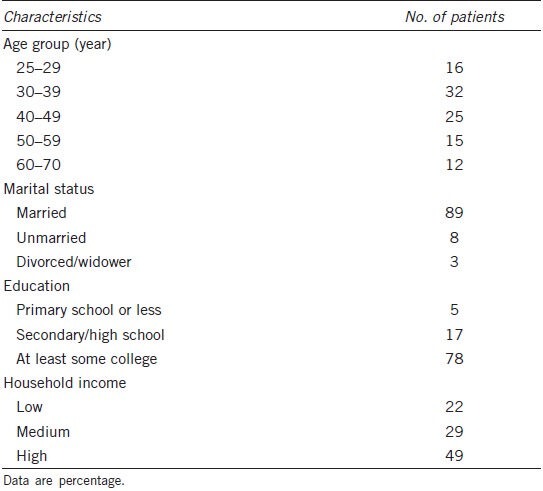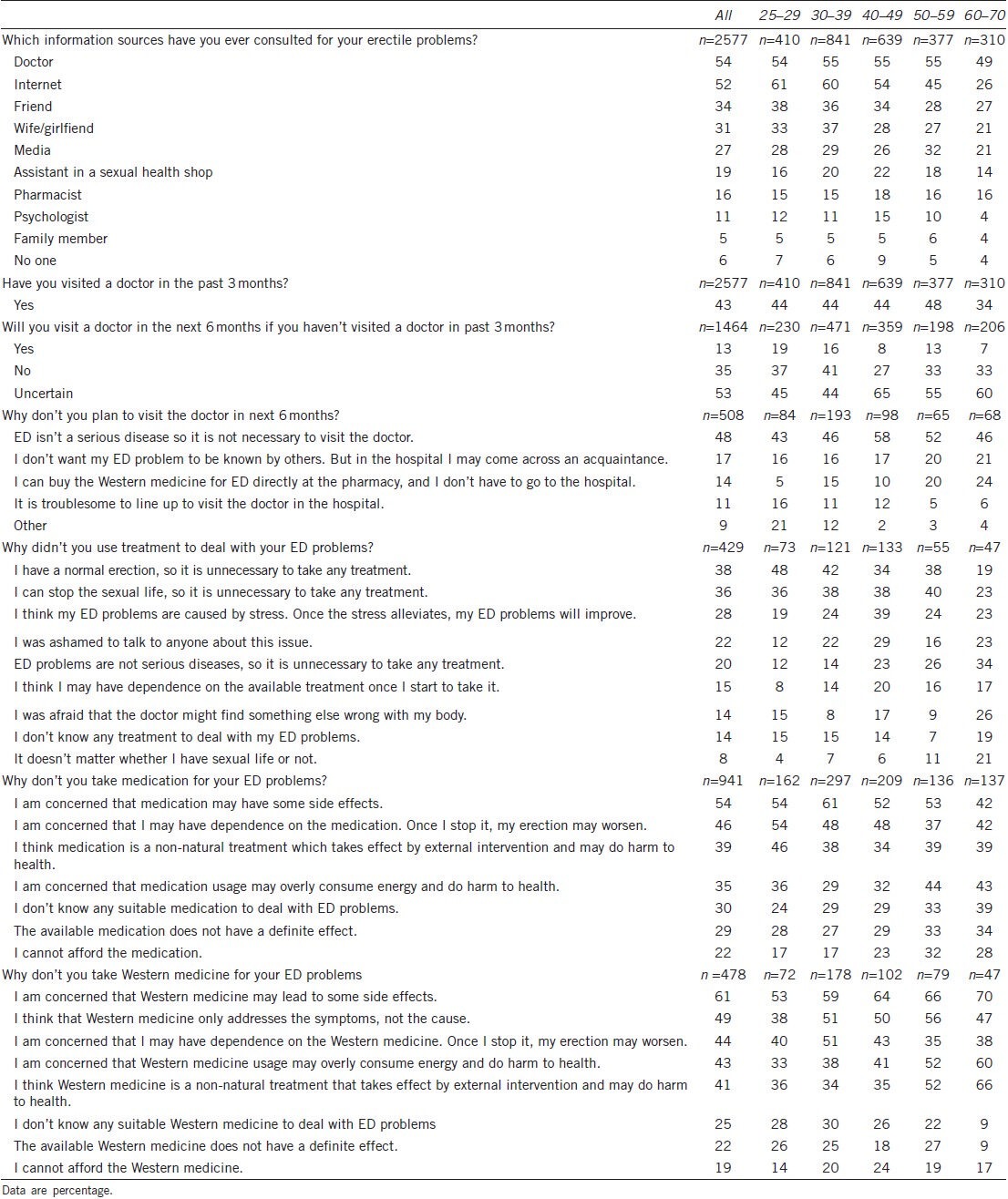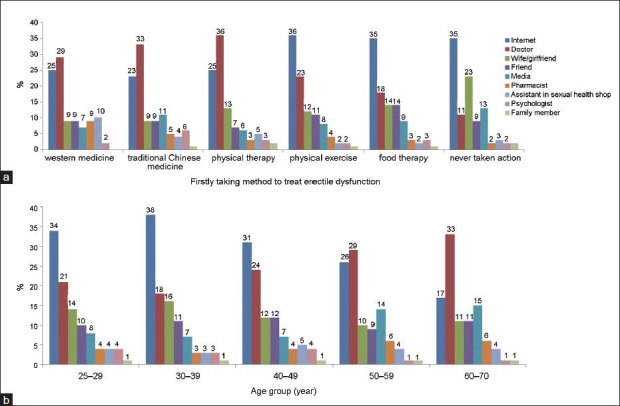Abstract
The behavior of Chinese patients seeking help for erectile dysfunction (ED) has not been described in detail. This was an observational study conducted using an outpatient clinic-based questionnaire survey of ED patients. From 2008 to 2009, physicians in 10 medical centers in China enrolled 2693 men (aged 25–70 years) diagnosed with ED. The diagnosis was based on the International Index of Erectile Function 5 (IIEF-5) Questionnaire. The men completed a survey that asked questions about demographics, marital status, education level and household income as well as help-seeking behavior and awareness of medical therapy. The mean age of the 2693 men was 43.4 ± 5.3 years; 73% were <50-years-old and 49% had a high household income. The mean time between noticing ED and taking the first treatment was 4.3 ± 2.1 months. Of the 2577 respondents, physicians (54%) and the internet (52%) were most frequently consulted sources for information about ED. Young ED patients preferred using the internet and older patients preferred consulting with physicians. Western medicine (19%) and traditional Chinese medicine (16%) were most frequently used for treatment. Young ED patients preferred to first search the internet for information, whereas older patients first asked physicians for help. Side effects of treatment were the greatest concern, especially for older patients. Physicians and the internet are frequently consulted for ED information and therapy. On the basis of these survey results, we believe that physicians in China should enhance health education about ED, especially via the internet.
Keywords: Chinese, erectile dysfunction, help-seeking behaviors, survey, treatment
INTRODUCTION
Sexual behavior and disorders have been well-studied in Western countries. Sexual problems are influenced by many factors, including the socioeconomic profile and culture.1,2 A few studies in developing Asian countries have addressed these questions.1,3,4,5 China is a developing country and has experienced rapid economic and social changes over the past 30 years, which has led to improved living standards and lifestyle changes. In an effort to improve quality of life, sexual behavior and disorders have attracted increasing attention. However, few studies have focused on the behavior among Chinese men who seek help for sexual problems, so little is known about the factors that might influence these behaviors.
The identification of help-seeking patterns among men with erectile dysfunction (ED) is important to clinicians, who want to identify potential barriers to seeking help for sexual problems. In addition, an improved understanding of sexual health issues regarding help-seeking behavior may help increase access to treatment and enhance quality of life. We used a clinic-based survey to describe help-seeking behavior among patients with ED in China.
MATERIALS AND METHODS
Study group
This was an observational study initiated by Peking University First Hospital conducted by use of an outpatient clinic-based questionnaire survey of ED patients. The study was approved by the ethics committee of all the centers and all patients provided written informed consent. From 2008 to 2009, urology or andrology physicians in 10 medical centers in China enrolled 2693 men between 25 and 70 years old who were diagnosed with ED. Face-to-face interviews were used. All patients were asked to complete the International Index of Erectile Dysfunction 5 (IIEF-5) Questionnaire. ED was diagnosed as an IIEF-5 score ≤21. Several questionnaires were reviewed from the published literature and modified according to the clinical practice of the authors. Patients completed another questionnaire about demographics and treating ED; both questionnaires were completed by the patients at the clinic.6,7,8
Questionnaires
The questionnaire about ED included questions on demographics, marital status, education level and household income. The classification of household income as low, medium or high was based on the distribution of income in each city.
Patients were asked how long they were aware of their erectile problem and whether they had sought help or advice from a variety of sources. More than one source could be indicated. Patients were also asked about the first method they used to treat ED: western medicine, traditional Chinese medicine, physical therapy, physical exercise or food therapy. The reasons for choosing these methods were queried, as were the sources for advice on these treatments. If patients did not take any action to treat ED, they were asked why, and if they did not take medicine to treat ED, they were asked why. If patients did not use Western medicine to treat ED, they were asked why. Patients were asked whether they consulted a physician about their sexual problems in the last 3 months, and if not, whether they would consult a physician in the next 6 months. Patients who reported no plan to visit the doctor in the next 6 months were asked why.
The prevalence of a specific characteristic was calculated by dividing the number of cases by the corresponding population. All analyses were conducted using the Statistical Package for the Social Sciences (SPSS), version 16.0 (SPSS Inc., Chicago, IL, USA).
RESULTS
We collected data for 2693 men. The mean age was 43.4 ± 5.3 years. In total, 73% of the respondents were younger than 50 years and 49% had a high household income (Table 1). A total of 2148 men responded about the time between noticing the ED and taking the first treatment. The mean interval was 4.3 ± 2.1 months. The distributions of the time intervals were less than 1 month, 14%; 1-3 months, 33%; 4-6 months, 31%; 7-12 months, 12%; >1 year, 10%.
Table 1.
Demographic characteristics of percentage of patients (n=2693) with erectile dysfunction in China

In total, 2577 men noted the sources they had consulted for their erectile problems; 94% had consulted one or more information sources. Physicians were most often consulted (54%) (Table 2). Other sources were the internet, 52%; a friend, 34%; wife/girlfriend, 31%; media, 27%; assistant in a sexual health shop, 19%; pharmacist, 16%; psychologist, 11% and family member, 5%. The patients first sought help from a physician, 23%; internet, 31%; a friend, 11%; wife/girlfriend, 13%; media, 9%; assistant in a sexual health shop, 4%; pharmacist, 4%; psychologist, 3% and family member, 1%.
Table 2.
Responses to questionnaire about behaviors for seeking help for sexual problems by age of men with erectile dysfunction in China

Overall, 2148 men reported that the first method they used to treat ED was Western medicine, 19%; traditional Chinese medicine, 16%; physical therapy, 6%; physical exercise, 26% and food therapy, 32%. As compared with patients who first used physical exercise and food therapy, those who first used Western medicine, traditional Chinese medicine or physical therapy consulted a physician more than other information sources (Figure 1). Young ED patients preferred the internet and older patients first turned to the physician for information.
Figure 1.

The information resource of Chinese patients with erectile dysfunction consulted first by (a) type of treatment used and (b) age group.
In total, 429 patients reported the reasons for non-action to resolve the ED problem (Table 2): 38% chose ‘I have a normal erection, so it is unnecessary to take any treatment’ and 36% chose ‘I can stop my sexual life, so it is unnecessary to take any treatment’. A total of 941 patients answered why they did not take medication for ED. Approximately half of the men in all age groups were concerned about side effects. The reason most patients cited for not taking Western medicine for ED, out of 478 men, was that the side effects were their greatest concern, especially for older patients. Older respondents were concerned that Western medicine use may overly consume energy and that Western medicine may harm health because it takes effect by external intervention and is not a natural treatment for ED.
More than half (57%) of the 2577 patients had not visited a physician in the previous 3 months and only 13% of these said they would visit a physician in the next 6 months; 35% had no plan to visit a physician and 53% were uncertain. For those with no plan to visit a physician (n = 508), 48% said they did not consider ED a serious disease and so did not feel the need to consult a physician and 17% said that they did not want their ED problem to be known by others and in the hospital they might encounter an acquaintance.
DISCUSSION
This is the first clinic-based survey to describe the behavior among men seeking help for ED in China. The major strengths of this study lie in the large clinical sample and the face-to-face interviews. As compared with other studies, our survey might more directly reveal clinic practice.
In our study, 73% of ED patients were <50-years-old. In China, young men might pay more attention to erectile function and believe ED has a negative impact on their quality of life, which led them to consult a physician. Only approximately half of our men had a high household income, so some financial barriers might deter them from seeking and obtaining the desired medical attention. The mean time between noticing ED and taking the first treatment was 4.3 months, which was shorter than in the Salonia et al.9 study, which had a mean time of 30.2 months (median 12.0; range 5–300 months). However, the mean age in our study was younger than in the Salonia et al.9 (43.4 vs 50.4 years) which might explain these findings.
Most patients consulted multiple sources of information for erectile problems. Physicians and the internet were the most-consulted sources and young patients tended to rely more on the internet and consulted more various sources. Moreira et al.10 investigated the behavior of men in the United Kingdom seeking help for sexual problems and found that sexual partners were the most consulted, followed by physicians. Buvat et al.11 confirmed these findings for men in France. The pattern of help-seeking behavior differs greatly between China and Western countries and the reasons for not seeking medical help also varied widely. Cultural factors influencing how comfortable people are about discussing sexual problems clearly plays a role.1,3 Patients in China might think that talking to a partner about sexual problems might make them appear to have no self-confidence, especially for a man. However, in the study by Tan et al.6 68% of respondents had spoken to their partner/spouse about their erection difficulties. This difference might be due to the different questions and populations between their study and ours. The respondents were recruited via telephone and the internet was not included in the questionnaire. The use of the internet for information is private and avoids embarrassment when talking about sexual problems with others.
In our study, the method used first to treat ED was Western medicine, then traditional Chinese medicine as well as physical therapy, physical exercise and food therapy. The patients used Western medicine, traditional Chinese medicine and physical therapy mainly on the recommendation of a physician. The internet played a greater role for patients who used physical exercise, food therapy and no action. Young ED patients preferred the internet and some authors have found a role for the internet in ED management.12,13 Young men in China with erectile problems might prefer the internet to seek ED solutions and then use nonprofessional health care.
A total of 429 patients (16.6%) reported the reasons for their nonaction to resolve ED problems. Those aged 25–39 years believed that they had normal erections, so they did not consider taking any action. As the age of patients increased, they tended to not consider ED a serious disease requiring treatment. We did not further explore the reasons for consulting a physician by these patients. However, these patients were clinically diagnosed with ED and might not realize that they had erectile problems at first. Physicians were an important information resource about ED, which agreed with results from studies in Western countries.14 However, physicians in China rarely ask patients about their sexual health during routine consultations. This apparent reluctance to initiate a discussion about sexual function might be due to an acknowledged lack of medical training in the management of sexual problems.
Side effects were the most frequent reason for not taking medicine and Western medicine, especially among the older patients. Meanwhile, older men were more concerned that using Western medicine may overly consume energy or harm their current health status because it takes effect by external intervention and is not a natural treatment for ED. Thus, Chinese ED patients care more about the side effects of drugs, especially Western medicines, even if they know the significant effect of these drugs. Thus, physicians in China should pay more attention to the health education of the ED patients.
There were some limitations of our present observational study. First, this study was based on routine clinical practice and not a prospective population-based study, which might be not able to reflect the accurate views of Chinese adult men about ED. However, these findings were more valuable to doctors in clinical practices. Second, there were no standard questionnaires about the help-seeking patterns aimed at Chinese men. The questions applied in our study were modified from those in other studies as mentioned above. Therefore, these questions might not be appropriate for Chinese men and their effectiveness should be verified in future studies. Finally, the response rates for some questions were not very high, which might lead to bias in our study.
CONCLUSIONS
Chinese men pay attention to their erectile problems. However, cultural and/or financial barriers may hamper them from seeking and obtaining proper medical attention. Physicians in China should enhance health education about ED, especially via the internet.
AUTHOR CONTRIBUTIONS
KZ designed and carried out the study and participated in drafting the manuscript. WY designed the study, performed the statistical analysis and drafted the manuscript. ZH carried out the study. JJ designed and carried out the study. All authors read and approved the final manuscript.
COMPETING INTERESTS
All authors declare no competing interests.
REFERENCES
- 1.Nicolosi A, Glasser DB, Kim SC, Marumo K, Laumann EO, et al. Sexual behaviour and dysfunction and help-seeking patterns in adults aged 40–80 years in the urban population of Asian countries. BJU Int. 2005;95:609–14. doi: 10.1111/j.1464-410X.2005.05348.x. [DOI] [PubMed] [Google Scholar]
- 2.Laumann EO, Glasser DB, Neves RC, Moreira ED, Jr GSSAB Investigators’ Group. A population-based survey of sexual activity, sexual problems and associated help-seeking behaviour patterns in mature adults in the United States of America. Int J Impot Res. 2009;21:171–8. doi: 10.1038/ijir.2009.7. [DOI] [PubMed] [Google Scholar]
- 3.Moreira ED, Jr, Kim SC, Glasser D, Gingell C. Sexual activity, prevalence of sexual problems, and associated help-seeking patterns in men and women aged 40-80 years in Korea: data from the Global Study of Sexual Attitudes and Behaviours (GSSAB) J Sex Med. 2006;3:201–11. doi: 10.1111/j.1743-6109.2006.00210.x. [DOI] [PubMed] [Google Scholar]
- 4.Ho CC, Singam P, Hong GE, Zainuddin ZM. Male sexual dysfunction in Asia. Asian J Androl. 2011;13:537–42. doi: 10.1038/aja.2010.135. [DOI] [PMC free article] [PubMed] [Google Scholar]
- 5.Lewis RW. Epidemiology of sexual dysfunction in Asia compared to the rest of the world. Asian J Androl. 2011;13:152–8. doi: 10.1038/aja.2010.108. [DOI] [PMC free article] [PubMed] [Google Scholar]
- 6.Tan HM, Low WY, Ng CJ, Chen KK, Sugita M, et al. Prevalence and correlates of erectile dysfunction (ED) and treatment seeking for ED in Asian Men: the Asian Men's Attitudes to Life Events and Sexuality (MALES) study. J Sex Med. 2007;4:1582–92. doi: 10.1111/j.1743-6109.2007.00602.x. [DOI] [PubMed] [Google Scholar]
- 7.Morales AM, Ibáñez J, Machuca M, Pol-Yanguas E, Schnetzler G, et al. The EPIFARM study: an observational study in 574 community pharmacies in Spain characterizing patient profiles of men asking for erectile dysfunction medication. J Sex Med. 2010;7:3153–60. doi: 10.1111/j.1743-6109.2010.01918.x. [DOI] [PubMed] [Google Scholar]
- 8.Moreira ED, Jr, Glasser DB, Gingell C GSSAB Investigators’ Group. Sexual activity, sexual dysfunction and associated help-seeking behaviours in middle-aged and older adults in Spain: a population survey. World J Urol. 2005;23:422–9. doi: 10.1007/s00345-005-0035-1. [DOI] [PubMed] [Google Scholar]
- 9.Salonia A, Ferrari M, Saccà A, Pellucchi F, Castagna G, et al. Delay in seeking medical help in patients with new-onset erectile dysfunction remained high over and despite the PDE5 era: an ecological study. J Sex Med. 2012;9:3239–46. doi: 10.1111/j.1743-6109.2012.02953.x. [DOI] [PubMed] [Google Scholar]
- 10.Moreira ED, Glasser DB, Nicolosi A, Duarte FG, Gingell C, et al. Sexual problems and help-seeking behaviour in adults in the United Kingdom and continental Europe. BJU Int. 2008;101:1005–11. doi: 10.1111/j.1464-410X.2008.07453.x. [DOI] [PubMed] [Google Scholar]
- 11.Buvat J, Glasser D, Neves RC, Duarte FG, Gingell C, et al. Sexual problems and associated help-seeking behaviour patterns: results of a population-based survey in France. Int J Urol. 2009;16:632–8. doi: 10.1111/j.1442-2042.2009.02316.x. [DOI] [PubMed] [Google Scholar]
- 12.Ayers SL, Kronenfeld JJ. Chronic illness and health-seeking information on the Internet. Health (London) 2007;11:327–47. doi: 10.1177/1363459307077547. [DOI] [PubMed] [Google Scholar]
- 13.Iverson SA, Howard KB, Penney BK. Impact of internet use on health-related behaviours and the patient-physician relationship: a survey-based study and review. J Am Osteopath Assoc. 2008;108:699–711. [PubMed] [Google Scholar]
- 14.Perelman M, Shabsigh R, Seftel A, Althof S, Lockhart D. Attitudes of men with erectile dysfunction: a cross-national survey. J Sex Med. 2005;2:397–406. doi: 10.1111/j.1743-6109.2005.20355.x. [DOI] [PubMed] [Google Scholar]


